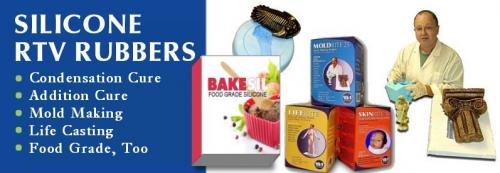Shore Hardness and Silicone Mold Rubbers
 We use a variety of mold making materials for making molds like alginate, clay, wax, silicone mold rubber, polyurethane rubber, latex rubber, thermoset mold rubber, plaster bandages, sodium silicate and so on. While each product is useful for particular castings - like alginate is almost always preferred for life casting projects – silicone rubber emerges as about the most versatile product as it can be used for almost any application.
We use a variety of mold making materials for making molds like alginate, clay, wax, silicone mold rubber, polyurethane rubber, latex rubber, thermoset mold rubber, plaster bandages, sodium silicate and so on. While each product is useful for particular castings - like alginate is almost always preferred for life casting projects – silicone rubber emerges as about the most versatile product as it can be used for almost any application.Silicone rubber is always highly durable, waterproof and extremely pliable. It does not stick to other things which make it suitable for general mold making of all kinds of inanimate objects such as soaps, statues, figurines, candles, model furniture, ornaments, refrigerator magnets and numerous other fine art or craft pieces. An added advantage is that silicone molds are long-lasting and you can make any number of copies from the same mold.
If you have used different kinds of silicone mold rubber, you must have noticed that they tend to vary in hardness. Some are very soft and extremely flexible while others may offer medium flexibility. If you look closely, you will also find that these varying forms of silicone rubber also have different Shore Hardness numbers associated with them.
What is Shore Hardness?
There are different Shore Hardness scales for measuring the hardness of different materials. Shore A and Shore D scales are used to measure the hardness of rubber compounds. It signifies the indentation hardness, i.e., the depth of indentation that will be created on the rubber with a specified force.
A Shore A hardness scale measures the hardness of flexible silicone mold rubbers that can vary from very soft and flexible to medium and somewhat flexible to even hard with almost no flexibility at all. It ranges from 0 to 100 with Shore A0 signifying extremely soft and gel-like rubbers. The higher the Shore A number, the harder is the rubber.
The Shore D hardness scale similarly measures the hardness of hard rubbers, semi-rigid plastics and hard plastics.
How is it useful in mold making?
A silicone mold rubber with a lower Shore A hardness number will tend to stretch easily and can be sealed properly as well. But a rubber with a higher hardness number will offer more resistance to abrasions and extrusions, which is lacking in the softer compounds.
The Shore Hardness proves helpful when you have to choose which silicone rubber should be used for making a mold. It signifies how easily you will be able to extract the original model from the rubber mold after it has cured. Similarly, it also indicates the level of flexibility in removing the final casts from the silicone rubber mold.
For instance, if you use Shore A70 rubber for making a mold of a delicate figurine, you will not get enough flexibility and will end up breaking the mold during extraction.
This makes it simpler, doesn’t it?
The author, Aarron Barry is an enthusiastic writer who loves writing on creativity, art likes topic and attention the detail. Through this article he shared his valuable information on mold making, silicone mold or sodium silicate. Want to know more about those topics, visit website.
Advertise on APSense
This advertising space is available.
Post Your Ad Here
Post Your Ad Here
Comments